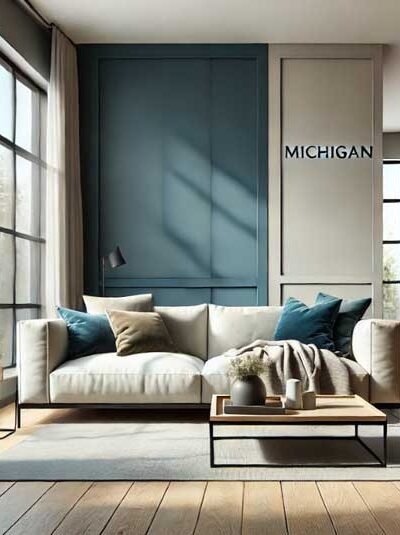A fresh coat of paint can transform a home, but a two-tone painting technique takes it a step further by adding depth, contrast, and a unique visual appeal. Homeowners in Michigan looking for a modern yet timeless update can achieve stunning results with this approach. Whether enhancing a living space or redefining a room’s character, two-tone painting provides an excellent way to introduce sophistication and style. With careful color selection and application techniques, this method elevates a home’s aesthetic and increases its value.
Choose the right color combinations
Selecting the perfect color palette is crucial for a successful two-tone effect. The key is to create harmony while maintaining contrast. Homeowners should consider colors that complement each other without overwhelming the space. Classic pairings include navy and white, beige and gray, or soft pastels with deep tones. For a bold look, contrasting shades such as black and white or deep blue and gold can make a statement. When choosing colors, it is essential to consider the room’s lighting, furniture, and decor to ensure the shades blend seamlessly with the overall design.
Define the painting style
Two-tone painting offers various styles to achieve different effects. A popular choice is the half-wall technique, where one color is applied to the upper half of the wall and another to the lower half. This method works well in dining rooms, bedrooms, and hallways. Another option is accent paneling, where one wall features a darker or bolder color while the remaining walls maintain a neutral tone. Vertical or horizontal divisions can also add a creative touch, making the space feel larger or cozier, depending on the chosen direction.
Use high-quality paint and tools
The success of any interior painting project depends on the quality of materials used. Investing in premium paints ensures better coverage, durability, and a smooth finish. Low-quality paint may require multiple coats, leading to increased costs and uneven results. Homeowners should also use painter’s tape to achieve clean, sharp lines between the two colors. High-quality brushes and rollers contribute to a professional-looking finish by preventing streaks and ensuring an even application.
Maintain consistency throughout the home
A cohesive color scheme enhances the overall appeal of a home. If multiple rooms feature two-tone walls, selecting a common color theme helps maintain visual flow. Neutral tones can connect different areas, while bold accent colors can provide variation without creating a disjointed effect. It is essential to consider the transition between rooms to avoid clashing styles. A well-thought-out design ensures that the home maintains a balanced and modern aesthetic.
Hire professional painters for flawless results
Achieving a seamless two-tone effect requires precision and expertise. Homeowners who want to avoid uneven lines, paint drips, or mismatched shades should consider hiring professionals. A skilled team specializing in affordable interior painting can provide expert guidance on color selection, application techniques, and finishing touches. Professionals ensure a polished and long-lasting result, saving homeowners time and effort.
Two-tone painting is an excellent way to modernize a Michigan home with a stylish and refined touch. The right color combinations, painting techniques, and quality materials contribute to a flawless outcome. Whether tackling the project independently or hiring professionals for interior painting, homeowners can achieve a sophisticated look that enhances their living space. By embracing this modern design trend, any home can achieve a fresh and visually appealing transformation.





Leave a Reply